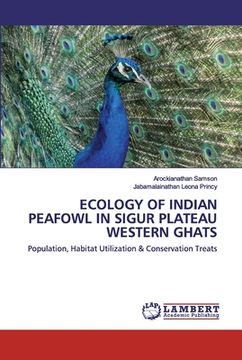Compartir
Ecology of Indian Peafowl in Sigur Plateau Western Ghats (en Inglés)
Arockianathan Samson
(Autor)
·
Jabamalainathan Leona Princy
(Autor)
·
LAP Lambert Academic Publishing
· Tapa Blanda
Ecology of Indian Peafowl in Sigur Plateau Western Ghats (en Inglés) - Samson, Arockianathan ; Leona Princy, Jabamalainathan
S/ 199,44
S/ 398,89
Ahorras: S/ 199,44
Elige la lista en la que quieres agregar tu producto o crea una nueva lista
✓ Producto agregado correctamente a la lista de deseos.
Ir a Mis Listas
Origen: Estados Unidos
(Costos de importación incluídos en el precio)
Se enviará desde nuestra bodega entre el
Viernes 26 de Julio y el
Martes 06 de Agosto.
Lo recibirás en cualquier lugar de Perú entre 2 y 5 días hábiles luego del envío.
Reseña del libro "Ecology of Indian Peafowl in Sigur Plateau Western Ghats (en Inglés)"
The present study aimed to estimate population status, habitat utilization and threats to Indian peafowl in Sigur Plateau, Tamil Nadu on November 2016 to March 2017. A total of 1091 individuals of peafowls were recorded in 487 sightings in 1080 km (2.28 0.05) with the encounter rate of 1.01 individuals/km. In Dry Deciduous Forest a total of 570 individuals of peafowls were recorded in 224 sightings in 460 km (2.28 0.05, ER=1.01 individuals/km). In Dry Thorn Forest a total of 521 individuals of peafowls were recorded in 254 sightings in 620 km (2.05 0.06) ER=0.84 individuals/km. A total of 19 roosting trees species were identified of which all 19 species were recorded in thorn forest similarly nine species were recorded in the dry deciduous forest. Highest number of roosts were recorded in Tectona grandis (n=27) the average height of the tree species was 14.46 and average Indian peafowl roost height was 11.25. Indian peafowl decreasing the reason for invading the human habitation was loss of food (n=60). Crop damage by peafowl shows that beans (50%) were highly damaged b followed by chilly (37%), tomato (5%) and maize (4%) and Corn (1%).
- 0% (0)
- 0% (0)
- 0% (0)
- 0% (0)
- 0% (0)
Todos los libros de nuestro catálogo son Originales.
El libro está escrito en Inglés.
La encuadernación de esta edición es Tapa Blanda.
✓ Producto agregado correctamente al carro, Ir a Pagar.

